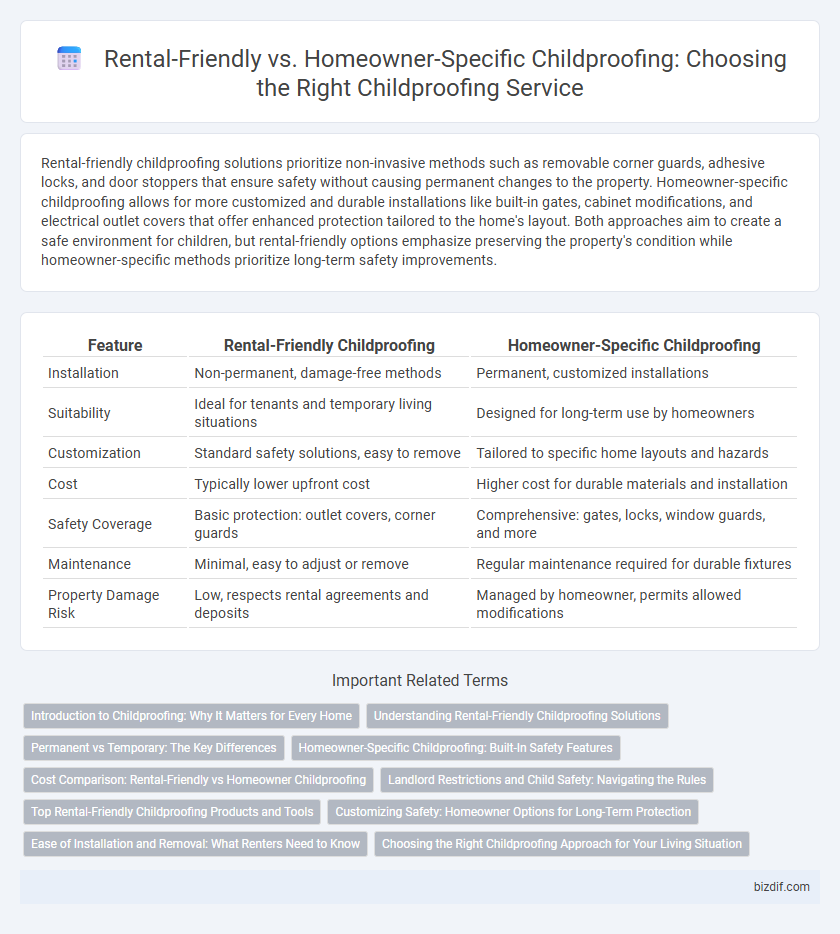Rental-friendly childproofing solutions prioritize non-invasive methods such as removable corner guards, adhesive locks, and door stoppers that ensure safety without causing permanent changes to the property. Homeowner-specific childproofing allows for more customized and durable installations like built-in gates, cabinet modifications, and electrical outlet covers that offer enhanced protection tailored to the home's layout. Both approaches aim to create a safe environment for children, but rental-friendly options emphasize preserving the property's condition while homeowner-specific methods prioritize long-term safety improvements.
Table of Comparison
| Feature | Rental-Friendly Childproofing | Homeowner-Specific Childproofing |
|---|---|---|
| Installation | Non-permanent, damage-free methods | Permanent, customized installations |
| Suitability | Ideal for tenants and temporary living situations | Designed for long-term use by homeowners |
| Customization | Standard safety solutions, easy to remove | Tailored to specific home layouts and hazards |
| Cost | Typically lower upfront cost | Higher cost for durable materials and installation |
| Safety Coverage | Basic protection: outlet covers, corner guards | Comprehensive: gates, locks, window guards, and more |
| Maintenance | Minimal, easy to adjust or remove | Regular maintenance required for durable fixtures |
| Property Damage Risk | Low, respects rental agreements and deposits | Managed by homeowner, permits allowed modifications |
Introduction to Childproofing: Why It Matters for Every Home
Childproofing ensures safety by minimizing hazards in living spaces, crucial for both renters and homeowners. Rental-friendly childproofing methods prioritize non-invasive solutions such as removable safety gates and adhesive outlet covers that protect without damaging property. Homeowner-specific childproofing allows permanent installations like secured cabinet locks and stair gates, providing tailored, long-term safety adaptations.
Understanding Rental-Friendly Childproofing Solutions
Rental-friendly childproofing solutions prioritize non-invasive, temporary methods such as removable corner guards, adhesive cabinet locks, and tension-mounted safety gates that do not damage walls or fixtures. These options maintain landlord approval while ensuring child safety in spaces where permanent modifications are prohibited. Understanding these products' ease of installation and removal is crucial for renters seeking effective childproofing without violating lease agreements.
Permanent vs Temporary: The Key Differences
Rental-friendly childproofing solutions emphasize temporary, non-invasive installations like adhesive locks and removable outlet covers, preserving the landlord's property and allowing easy removal without damage. Homeowner-specific childproofing often involves permanent fixtures such as screwed-in safety gates or customized cabinet locks, offering durable protection tailored to the home while potentially altering the property structure. Understanding these differences ensures appropriate child safety measures aligned with property ownership and lease agreements.
Homeowner-Specific Childproofing: Built-In Safety Features
Homeowner-specific childproofing includes built-in safety features such as custom cabinetry locks, secured stair gates, and integrated outlet covers designed to seamlessly blend with the home's interior. These permanent installations enhance safety by reducing the risk of accidents while maintaining aesthetic appeal. Tailored solutions often include reinforced door locks and safety glass, providing long-term protection essential for family households.
Cost Comparison: Rental-Friendly vs Homeowner Childproofing
Rental-friendly childproofing solutions typically cost less due to their temporary and non-invasive nature, using removable anchors and adhesive products that avoid damage to walls and fixtures. Homeowner-specific childproofing often involves more expensive, permanent installations like custom gates, cabinet locks, and safety hardware integrated into the home's structure. The upfront cost for homeowners is higher, but long-term investment in durable safety features increases property value and provides enhanced security tailored to the home's layout.
Landlord Restrictions and Child Safety: Navigating the Rules
Rental-friendly childproofing prioritizes removable, non-damaging solutions to comply with landlord restrictions while ensuring child safety, such as adhesive corner guards and pressure-mounted gates. Homeowner-specific childproofing allows more permanent modifications like installed cabinet locks and safety gates that require drilling, offering enhanced durability and protection. Navigating these rules requires balancing legal property constraints with effective childproofing measures tailored to the dwelling type.
Top Rental-Friendly Childproofing Products and Tools
Top rental-friendly childproofing products include removable corner guards, adhesive outlet covers, and tension-mounted safety gates that avoid damage to walls and fixtures. These tools provide effective protection without requiring permanent installation, making them ideal for renters who need to preserve their security deposit. Brands like Roving Cove, Safety 1st, and Munchkin offer highly rated, non-invasive solutions specifically designed for rental properties.
Customizing Safety: Homeowner Options for Long-Term Protection
Homeowner-specific childproofing offers customizable safety solutions tailored to permanent structures, including reinforced stair gates, secured cabinets, and tailored outlet covers designed for long-term use. Unlike rental-friendly options, these modifications can be integrated directly into the property's framework for enhanced durability and effectiveness. Homeowners benefit from investing in personalized child safety measures that provide lasting protection and increase overall home security.
Ease of Installation and Removal: What Renters Need to Know
Rental-friendly childproofing products prioritize ease of installation and removal to prevent damage to walls and fixtures, using adhesive hooks, removable corner guards, and tension rods. Homeowner-specific childproofing often involves more permanent solutions like drilling or mounting hardware directly into surfaces for enhanced durability. Renters should choose non-invasive options that maintain landlord property standards while ensuring child safety.
Choosing the Right Childproofing Approach for Your Living Situation
Rental-friendly childproofing emphasizes non-invasive solutions, such as removable safety gates, adhesive outlet covers, and temporary cabinet locks, ensuring no permanent alterations that could affect lease agreements. Homeowner-specific childproofing allows for more customized, permanent installations like built-in stair gates, wall-mounted corner guards, and secured heavy furniture, tailored to enhance long-term safety and durability. Selecting the right approach depends on lease restrictions, duration of stay, and willingness to invest in permanent safety measures.
Rental-friendly childproofing vs Homeowner-specific childproofing Infographic

 bizdif.com
bizdif.com